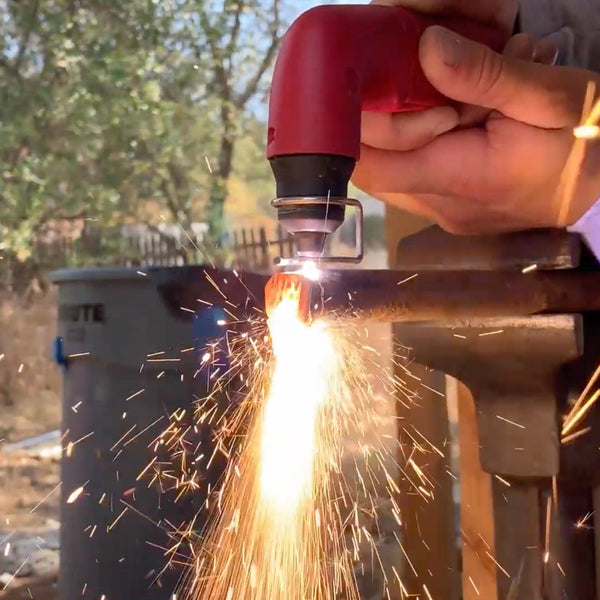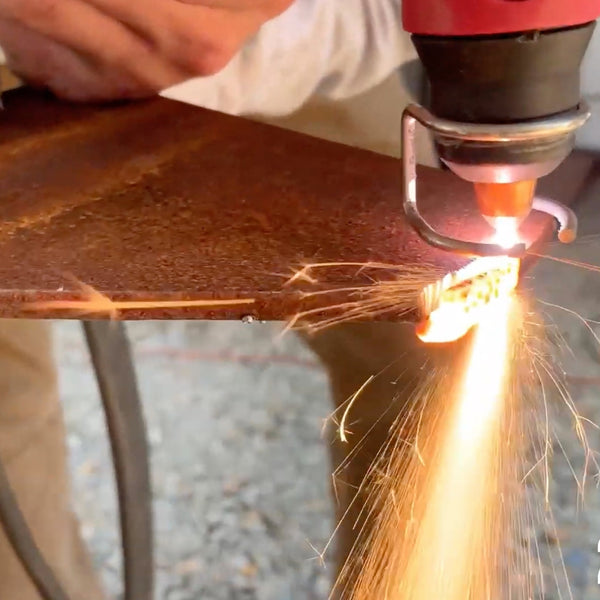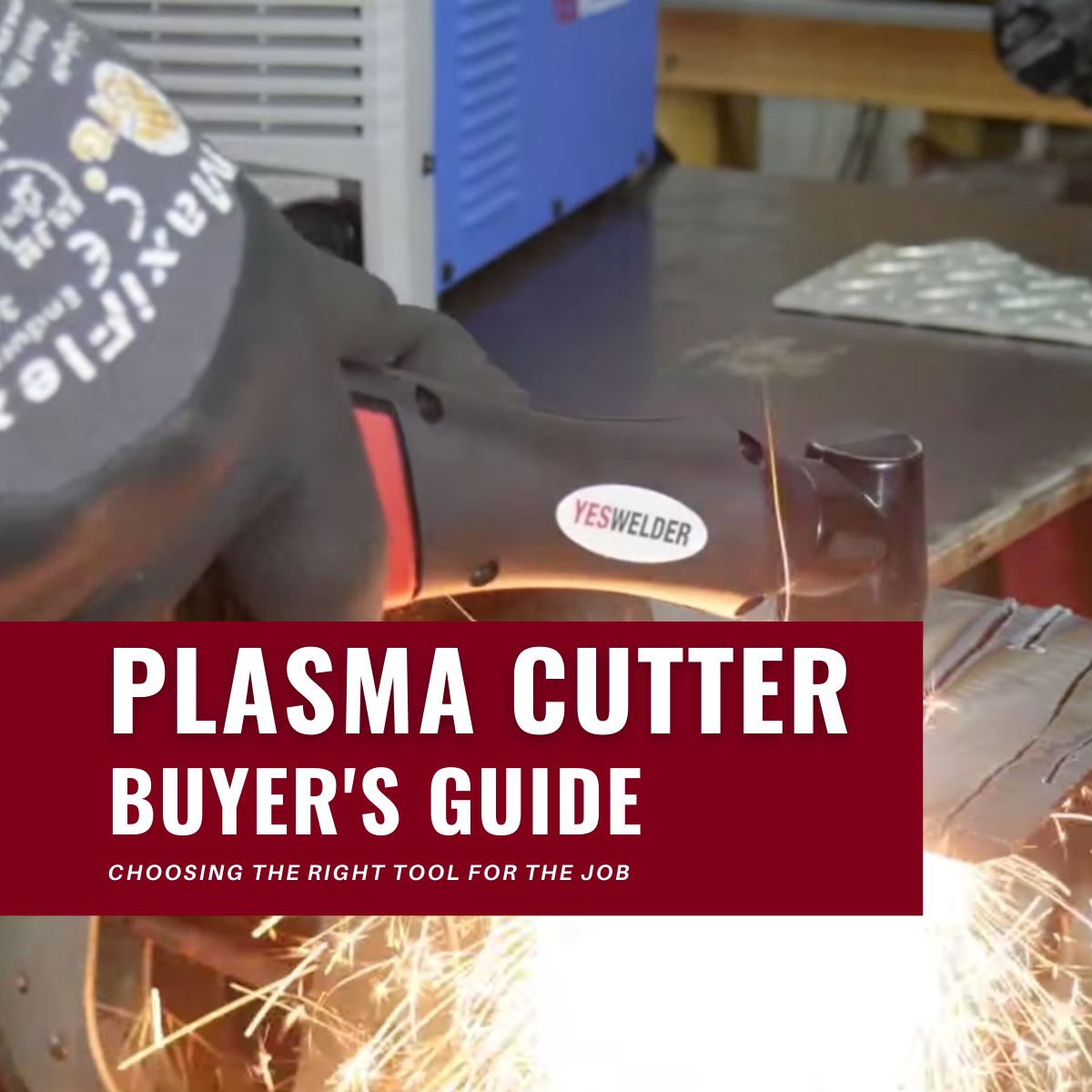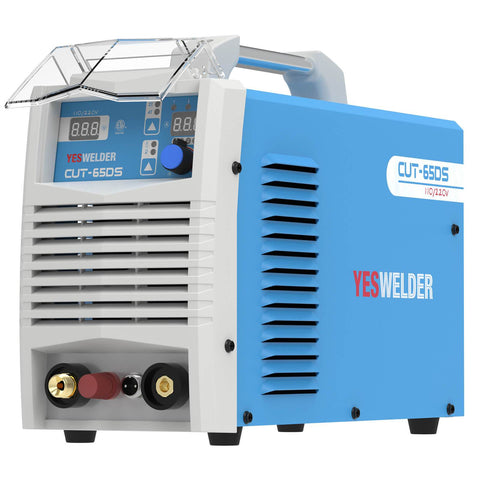Choosing the Right Plasma Cutter
YesWelder Plasma Cutters Comparison
|
|
|
|
|
|
Model |
YesWelder CUT-45DS | YesWelder CUT-55DS | YesWelder CUT-65DS |
|
Input Voltage |
110/220V |
110/220V |
110/220V |
|
Recommended Breaker Size |
63A |
63A |
63A |
|
Air Compressor Requirement |
12 CFM at 60PSI |
5-7 CFM at 60PSI |
5-7 CFM at 72PSI |
|
Amperage Output |
110V: 10-20A 220V: 20-45A |
110V: 10-35A 220V: 10-55A |
110V: 15-45A 220V: 15-65A |
|
Duty Cycle |
60% at 45A |
60%@55A |
60%@65A |
|
Maximum Clean Cut Thickness (Mild steel) |
110V: 1/8 in. 220V: 5/16 in. |
110V: 5/16 in. 220V: 1/2 in. |
110V: 5/16 in. 220V: 5/8 in. |
|
Maximum Severance Thickness (Mild steel) |
110V: 5/32 in. 220V: 15/32 in. |
110V: 15/32 in. 220V: 3/4 in. |
110V: 5/8 in. 220V: 63/64 in. |
|
Arc Starting Method |
High-Frequency |
High-Frequency |
Blowback Start |
|
Non-Touch Pilot Arc |
No |
Yes |
Yes |
|
Digital Display |
Yes |
Yes |
Yes (Two displays) |
|
2T/4T |
No |
Yes |
Yes |
|
Gas Check Mode |
No |
Yes |
Yes |
|
Post-flow Time Adjustment Range |
5 or 10s |
20s |
5-20s |
|
Cutting Torch Length |
13 feet |
13 feet |
13 feet |
|
Weight |
11 lbs |
14.55 lbs |
21.8 lbs |
YesWelder Plasma Cutter Buying Guide
Today, the market is quite saturated with inverter plasma cutters, and most don’t offer a proper ratio of provided value and cost.
Here at YesWelder, we offer different grades of plasma cutters in different price brackets to save you money and get you the machine that fulfills your needs.

But if you are new to plasma cutting, choosing a cutter may get challenging. So, we wrote this guide to help you get a suitable unit without guesswork.
Before discussing the YesWelder plasma cutters, let’s talk about the most important specs of a plasma cutter and the features you may or may not need.

To save money on your purchase and not miss out on any important feature, it’s best if you match the plasma cutting machine with your budget and your typical metal cutting needs.
Amperage Output And Maximum Cutting Thickness
The first thing to consider is the maximum metal thickness you need to cut. It’s a good idea to get a cutter with a bit more power than what you’d typically need, but don’t go overboard with the power if you are on a budget.

For most hobbyist applications, a plasma cutter with the output of 45A will do just fine, but higher amperages also provide a higher clean cut thickness.
But what is a clean cut? Won’t all plasma cutters cut the same thickness equally?
To put it simply, no.

Every plasma cutter is rated for a maximum clean cut and a maximum severance cut. The higher the amperage output, the thicker is the metal it can cut clean. This means there won’t be much residue left to remove from the newly cut edge.

However, a maximum severance cut is not as pretty as a clean cut. So, a machine with a lower amperage output may cut a bit thicker, but the edge will require additional post-cutting work. This takes time and effort, so it’s always better to get as powerful a cutter you can afford.

Cutting Speed
Plasma cutting speed is rarely discussed, but it's also important to consider. The speed is closely related to the output amperage. So, a more powerful plasma cutter will cut faster, allowing you to move the torch with more speed and achieve the desired cut.

If you are cutting a metal thickness that matches your machine’s maximum cutting thickness rating, the speed will be slower than if you were cutting a thinner gauge. So, if speed is vital in your work, consider getting a more powerful plasma cutter.
Input Voltage
Most homes in the US have 110/120V available, but it’s possible to install a 220V outlet. This requires additional investment, but it allows you to use more powerful plasma cutters, welders, and other power tools.

But if you don’t plan to install a 220V outlet or if you plan on using a plasma cutter for work on-site where the 220V is unavailable, you’ll have to stick to the 110V input machines.
Thankfully, many plasma cutters support dual voltage input (including models from YesWelder), providing additional versatility and letting you work with what you have available.

However, the 110V input won’t provide the maximum output of the dual voltage plasma cutter. The only way to do that is to plug it into a 220V outlet. Even so, some cutters provide more power with a 110V input than others, and our YesWelder plasma cutters offer plenty of power with 110V alone and a lot more with a 220V input.

Duty Cycle
The last but definitely not least important aspect of power output is the duty cycle. It represents an interval of how long the plasma cutter can continuously cut at a rated amperage output. It’s presented in a percentage value of a 10 minutes interval.

For example, a plasma cutter with a duty cycle rating of 60% at 55A can continuously cut for 6 minutes (60% of 10 min.) at a power output of 55A. Afterward, it needs to cool for the remaining 4 minutes of the 10 minutes interval.
In the same example, if you set a lower amperage output than what is rated at, it will have a higher duty cycle. Likewise, it will have a lower duty cycle if it outputs higher amperage.

All YesWelder plasma cutters have exceptional duty cycle ratings, but this is generally something to consider. If you plan on making long cuts, you should get a cutter with a sufficient duty cycle. You don’t want to have to stop cutting mid-way.
Air Compressor Requirements
Most air compressors will suffice for minimum air compressor requirements. Still, you should always check the specification of the plasma cutter and make sure that your air compressor can provide the necessary airflow pressure.

If you do a lot of plasma cutting, it's a good idea to have a more powerful compressor than the minimally required by the cutter. Additionally, the supplied air must be free from moisture.
That’s why all YesWelder plasma cutters include an air filter that removes the extra moisture and other contaminants from the supplied air before it goes into the air inlet.

If the air is not adequately filtered from moisture, the consumables will wear down faster, and the plasma cut won’t be as quality. That’s because these contaminants can cause arcing between the electrode and the nozzle, and increase the temperatures the consumables are subjected to, leading to their early end-of-life.

High-Frequency Start Or Blowback Start?
A plasma cutting torch needs a way to heat up the compressed air so that it reaches the ionized temperature. This is achieved by striking the arc between the electrode in the torch and the nozzle before the arc is transferred to the workpiece you are cutting.
There are two ways to initiate the arc start, a high-frequency start or a mechanical blowback start. So let’s explain their advantages and disadvantages.

High-Frequency Arc Start (HF)
The plasma cutting torch keeps the electrode within the nozzle tip, and this is used as an advantage with an HF start. The power source (plasma cutter) contains an HF generator and a relay switch that makes the nozzle positively charged while the electrode is negatively charged.
When the torch trigger is pressed, the compressed air begins to flow through the torch, the relay switch activates, charging the nozzle positively, and an HF generator sends an HF charge through the electrode. The electrode is negatively charged and its electrons jump to a positively charged nozzle, forming an arc.

Photo by drdflo.com
Once you approach the torch tip to the metal, the arc is transferred to the metal, the relay switch turns off, removing the charge from the nozzle. Therefore, the electrode remains negatively charged, but the ground clamp attached to the workpiece provides the positive charge, completing the circuit and letting you cut through the metal like a hot knife through butter.

This HF arc start action is known to interfere with sensitive electronics like CNC machines, laptops, smartphones, and medical devices. Therefore, removing all such devices from work vicinity is recommended, especially medical devices. The HF start is not necessarily going to cause interference, but it could. This arc starting method is usually found with less costly machines, while the mechanical blowback start is a feature of a bit more expensive cutters.

Blowback Arc Start
With the blowback arc start, there is no high HF current involved. As a result, it’s safer for sensitive electronics like CNC machines and other devices.
The construction of the torch is different. The electrode is in a “dead short” connection with the nozzle. Again, the electrode is negatively charged, while the nozzle is positively charged. And because the electrode is physically touching the nozzle, there is no arc between them.

Photo by weldingpros.net
However, when the plasma torch trigger is pressed, the compressed air enters the torch and “blows back” the electrode held by a spring, opening the connection between the nozzle and the electrode. As a result, the electricity jumps from the negative electrode to the positive nozzle, and the arc is formed without the HF we discussed before.
Pilot Arc Or Non-Pilot Arc?
Many plasma cutters on the market offer a pilot arc technology, including YesWelder plasma cutters. But, the non-pilot arc plasma cutters are less costly, and we also have one such model.
One special note here is that both HF and blowback arc starting methods support a pilot arc. In fact, both of the methods described above show how the pilot arc works. The whole point of the pilot arc is to strike the arc between the electrode and the nozzle first, and then transfer that arc to the metal being cut.

Photo by weldingpros.net
This allows you to cut dirty and rusty metal because you don’t have to rely on the conductivity necessary with a non-pilot arc. Another advantage of the pilot arc is that it allows you to cut metal sideways too. So, you can bevel the thick metal pieces before welding instead of using Oxy-flame or a grinder.

Image by researchgate.net
Additional Functions
Depending on the amount of metal you plan on cutting and the desired quality, you could benefit from many additional features plasma cutters provide.
The post-flow time setting allows you to modify the length of time of how long the compressed air should continue cooling the torch after the arc is extinguished. It’s also good to have a gas check ability to verify if everything is okay with the air supply.
Another helpful feature is the 2T/4T mode. The 2T is your standard cutting mode which starts the arc once you press-hold the trigger and cuts it out when the trigger is released.

The 4T (four touches) mode lets you press-release the trigger to start the arc, and it will keep cutting until you press-release the trigger again. This prevents hand fatigue when making long cuts, and it's best when combined with a long duty cycle for high-volume cutting.
Some machines have a dedicated metal mesh cutting mode, allowing you to cut extruded mesh metal more efficiently. Additionally, a digital display with an infinitely adjustable control knob for amperage output is useful and provides better control than traditional analog controls.
YesWelder CUT-45DS
Our most affordable YesWelder CUT 45DS offers plenty of power for occasional hobbyist plasma cutting needs. Its lightweight, portable, and supports dual voltage input, making it also a good choice for professionals who need something light for cutting on the go.
It has a non-pilot arc, so it doesn’t offer the full pilot arc advantages like the CUT 55DS and CUT 65DS we’ll discuss soon, but its limited features make it very cost-effective for people who don’t want to invest much in a plasma cutter. But even if it doesn’t have all of the features our more expensive models do, it does allow you to modify the post-flow time.
The YesWelder CUT 45DS severs up to 15/32 in. thick, but if you want a clean cut, you can achieve it with up to 5/16 in. thick mild steel.
It has a standard High-Frequency arc start, which allows efficient arcing. In addition, it comes with a built-in air gauge and an external air filter to remove excess moisture for longer consumable life and better cuts.
YesWelder CUT-55DS
The YesWelder CUT 55DS is a more powerful unit and offers more features. It supports a fully-fledged non-touch pilot arc that cuts through rusty, painted, and rough surfaces without issues.
This plasma cutter can be used in construction, demanding fabrication work, a welding shop, or a DIY hobbyist environment thanks to affordable cost and provided power. It severs up to 3/4 in. thick mild steel and achieves a 1/2 in. clean cut with a 220V input. But, it’s also very powerful with a 110V input, making it a good choice for home and on-site cutting.

One of the stand out features is the 2T/4T mode, allowing you to fully utilize its lengthy duty cycle of 60% at 55A output or 100% at 35A. Combining 4T with a 100% duty cycle at 35A lets you cut for a long time in a professional environment. It also supports gas check and wire mesh cutting modes, helping you better handle your work.
YesWelder CUT-65DS
Our most comprehensive plasma cutter yet is the YesWelder CUT 65DS. It offers a lot of power for an inverter, dual-voltage, lightweight plasma cutter. Plus, we made sure it’s still relatively affordable, especially considering the included features.
The CUT 65DS supports a non-touch pilot arc and a mechanical blowback arc start. With this plasma cutter, you don’t have to worry about High-Frequency interference with sensitive electronics. Plus, the pilot arc lets you weld through painted and rusty metals with ease.

The provided 65A of maximum output severs up to 63/64 in. and provides a clean cut up to 5/8 in. thick mild steel. In addition, the 100% duty cycle at 45A and 60% at 65A let you cut until you get your job done without making unnecessary pauses for the machine to cool down.
It has two digital displays; one for voltage readout and another for amperage output control. Plus, features like 2T/4T, wire mesh mode, gas check, and post-flow adjustability make your life easier and let you get the job done faster.
Conclusion
This plasma cutter guide covered the basics of these machines to help you make an informed decision. All of our plasma cutters are affordable within their power range. That’s because we strive to provide a low barrier to entry while providing as many features as possible with our units.

If you are a beginner just starting to plasma cut, or you don’t plan to use the machine for very thick metal, the CUT 45DS is the least costly choice. The CUT 55DS is a more powerful unit for hobbyists and professionals who appreciate the pilot arc addition. It’s definitely worth the upgrade if it fits your budget.
The CUT 65DS is the most powerful choice and provides multiple additional features, including the blowback start safe for sensitive electronics in the work area.










I recently purchased a MP200 and am trying to figure out how to put it all together. I’m finding some information on line but including a manual with the machine would have been nice.
Greg Netzorg,
The HF and blowback arcs are basically the same as the pilot arc except that with the pilot arc you don’t have to depend on the cut material to start the output.
With HF and blowback the arc is inside the tip until you get close enough to the material to transfer the arc. This requires clean metal.
The pilot arc starts in “cut mode” which means you can cut through paint and rust and also cut at angles that are hard to do otherwise.
Hope that helps.
I purchased a cut 55 DS back in Nov of 2021. The torch would not stay lit when I released the handle. The support team at Yes Welder was great and ran me through some things to try. I sent them a video of what exactly was happening and they sent me a new machine. Keep the old one they said. I got the replacement within a week, and it had multiple problems. Pressure gauge didn’t work on the front, and it also had torch issues. Again I proved what was happening and the refunded my original purchase price minus the shipping. These folks will take care of you if things go wrong, That is a big plus to me. I also recently purchased the TIG 250 P AC/DC. So far so good.
Which of the above plasma cutter types best describes the one that is incorporated as one of the features in your 5 in one machine?
I have the 55DS and love it.
Great explanations on the workings of plasma cutters, but I’m a bit confused about the pilot arc. In the figure following the pilot arc section, the pilot arc is shown between the electrode and the nozzle. Isn’t this what the HF and blowback arc start is? The written description implies the pilot arc is between the electrode and the workpiece since you don’t need a clean workpiece to start your cut if you have the non-touch arc feature. Your specs section shows the 45DS having HF arc start but not the non-touch pilot arc. How do you start cutting with the 45DS?
Leave a comment